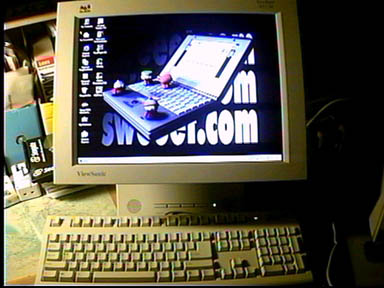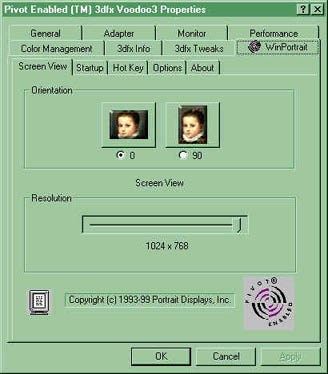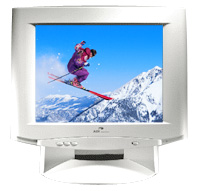|
Product Specifications
|
| |
VPA150
|
MicroScan
6L
|
|
Disptype
|
Active
matrix TFT |
Active
matrix TFT
|
|
Display
colors
|
1.6
million |
16.7
million
|
|
Pixel
pitch
|
0.300
mm
|
0.297
mm
|
|
Viewable
area
|
15
inch
|
15
inch
|
|
Maximum
resolution
|
1024
x 768
|
1024
x 768
|
|
Picture
control
|
Digital
|
Digital
|
|
Contrast
ratio
|
300:1
|
200:1
|
|
Brightness
|
200
cd/m2
|
200
cd/m2
|
|
Scanning
frequencies
|
Vertical
50-75 Hz / Horizontal 30-62 Hz |
Vertical
56-75 Hz / Horizontal 31.25-68 Hz
|
|
Input
signal
|
RGB
analog, 0.7Vpp
|
RGB
analog, 0.7Vpp
|
|
Sync
signal
|
separate
sync TTL level
|
separate
sync TTL level
|
|
Viewing
angle
|
60
degree left/right, 45 degree up/down
|
60
degree left/right, 45 degree up/down
|
|
Plug
& play level
|
VESA
DDC 1/2 compatible
|
VESA
DDC 1/2 compatible
|
|
Power
consumption
|
40W
|
35W
|
|
Dimensions
|
385.2
x 396.2 x 168.9 mm
|
410
x 429.4 x 213.9 mm
|
|
Weight
|
Net.
12.8 lbs / 5.8 kg |
Net.
11.9 lbs / 5.4 kg
|
|
Video
input
|
NTSC,
PAL |
NTSC,
PAL
|
<Introduction><Setup and configuration><Usability><Pros
& Cons><Conclusion><Rating>
Back
to top
Introduction
Viewsonic and
Adi are two common names for monitors in the PC market. From standard
15" end user monitors to 21" professional series, both manufacturers
are known to carry a wide range of monitors. Not too long ago, with
the advancement of technology and a boom in the field of semi-conductors,
flat panel LCD monitors are gradually emerging into the market.
Their existence threaten the monopoly of CRT monitors, which up
to this point of time, has been the only mean to convert the digital
signal from our display cards to viewable images on the screen.
With flat panel LCDs offering a slim profile, taking up not more
than any additional desk space that is required, all of a sudden,
CRT monitors seem a whole lot more bulky and heavy.
Despite the
fact of not using conventional CRTs to emit electrons, LCD monitors
are still able to produce a distortion free display with crisp,
sharp images. With so many goodies about LCDs, you can expect these
futuristic monitors to come with a hefty price tag. In this review,
I will be evaluating 2 LCD monitors together. One of them will be
the VPA150, a 15" flat panel LCD from Viewsonic while the other
15" LCD is the Microscan 6L from ADI.
 
Back
to top

The
ViewSonic VPA150 offers a wide tilting angle.
Setup
and configuration
The VPA150 came
attached with a sculptured base that allows the screen to tilt.
At the back of the base, apart from the power switch, AC and VGA
input, you will also find an audio input alongside with a mic input.
On the front, sandwiched between two fifty-cents sized perforated
circular cutouts, are 4 push-buttons controls for function, plus,
minus and recall. All screen adjustments, including the volume of
the built-in speakers, are made via an on-screen menu using these
four buttons.
The Microscan
6L on the other hand does not come attached with a base. This is
because the 6L offers wall mounting and hence, the consumer is given
the choice of whether to mount it on the wall or attach it to the
base. The monitor does not take 230V of AC power supply directly;
instead, a DC converter is needed to convert the 230V of AC to a
regulated voltage supply. Similar to the VPA150, there are only
4 push-buttons controls on the front panel of the LCD. Three on
the left hand side controlling menu, plus and minus while the last
is the power switch which is located on the right.

The
ADI MicroScan 6L offers wall mounting.
Setting up both
the LCDs were easy. I simply connected them to the display adapter
and under Windows 98, both monitors were detected as plug and play
monitors. After updating with the appropriate drivers, both monitors
gave me the correct options of refresh rates and colour resolutions.
One useful feature that could be found on both flat panels is the
Auto Center feature which really did save me a lot of time and hassle
from adjusting the screen to the correct viewable position given
a chosen resolution and refresh rate.
Back
to top
Usability
With both LCDs
featuring On Screen Display (OSD) Control, it does not require much
effort to configure the screen settings. Basic settings like adjusting
the contrast, brightness, H-size, H/V-position, color select, auto
size, tuning, fine tune and auto-tune could be found in the OSD
control. For the VPA150, the OSD also include volume control for
the built-in speakers.
After using
several screen resolutions and refresh rates to test out both LCDs,
I realize that both flat panels have similar characteristics (Actually,
it is typical to all LCDs). Both LCDs are capable of displaying
excellent colour images with sharp text only at their highest true
resolution and refresh rates. If you have a resolution of 640x480,
what you will see is an ugly, jagged display on the screen. How
jagged the display will be, depends on how much lower resolution
you are using from the maximum of 1024x768. The reason for this
is because for LCD displays, each pixel has a definite boundary
and over the surface of the entire pixel, the colour or luminance
level is the same. A conventional CRT however does not have restricted
boundaries for each pixel and hence, colour and luminance level
can change over the surface area of a pixel. In this way, the jaggedness
does not exist in CRTs since adjacent pixels can blend together.
In addition
to the resolution, refresh rates also affects the quality of the
output. Both the VPA150 and the MicroScan 6L are able to produce
sharp, crisp images with excellent vibrant colours at 75Hz refresh
rate given the maximum resolution. However, once the refresh rate
is forced to 60Hz, the vibrancy of the colour along with the sharpness
of the output will decrease significantly.
Once set back
at the maximum resolution and refresh rate, image quality is excellent.
When I tried some fast moving graphics such as games and movie clips,
there was no ghosting observed on either LCDs. One other thing I
observed about the MicroScan 6L was that it effectively produced
subtle shades of colour than compared with the VPA150.
|
Pictures of the MicroScan 6L (Click on to enlarge)
|
|
Text
is sharp even from a distance
|
The
OSD Menu
|
Offers
sharp image at max. resolution and refresh rate
|
|
|
|
|

Look!
That's the space that is required for a LCD!! Don't you feel claustrophobic
with your conventional CRT??
Back
to top
Pros
and Cons
The VPA150 has
a few features which the MicroScan 6L does not offer. Firstly, the
VPA150 comes with a pair of built-in speakers. Though not the best
speakers in its range, the 2x1W-integrated amplifier is able to
produce a decent coherent sound without too much emphasis on the
bass.
The other useful
feature packaged with the VPA150 is the ability to rotate the display
into a portrait mode, both physically as well as using the software,
PerfectPortrait that comes with the LCD. After installing the software,
the application will idle in your task tray until activated. When
you feel that by changing into portrait mode, it will facilitate
reading of your A4 sized documents, then simply click on the icon
and you will see your screen display being rotated 90 degrees anti-clockwise
(from 1024x768 to 768x1024). After which, you will rotate the screen
physically into the portrait mode. The only drawback to the PerfectPortrait
software is that once the application is loaded into memory, whether
in use or not, DirectDraw support is automatically disabled. However,
I foresee that the later versions of the software will rectify this
problem. Another minor bad point is that the VPA150 only offers
18-bit colour (260,000 colours), which can be a limitation for the
serious graphic designers who run photos and colour-intensive applications.
 
Changing
the screen resolution at the click of a button

PerfectPortrait
Software
 
The
VPA150 offers a choice of landscape or portrait mode.
Back
to top
Conclusion
The analog VPA150
offers more saturated colours than many LCDs. Packaged with the
speakers and pivot capability, most corporate offices will find
this flat panel a trendy as well as useful piece of office equipment.
As for the MicroScan 6L, though it doesn't come packaged with as
much punch as the VPA150, it will serve its purpose as a space saving
monitor for most people. Unfortunately, as for now, these flat panels
still come with a hefty price tag of approximately $2000 each, which
leaves us end users hanging on to our good old, conventional CRT
monitors.
Back
to top
|
Overall
Rating
(Out of a maximum of 5 Star)
|
| |
VPA
150 |
MicroScan
6L |
| Installation |
*** |
*** |
| Performance |
****½ |
** |
| Price |
** |
** |
| Build
Quality |
**** |
*** |
| Overall
Rating |
**** |
*** |
 
Any comments/remarks?
Submit your views to this review here.
Back to top
|



